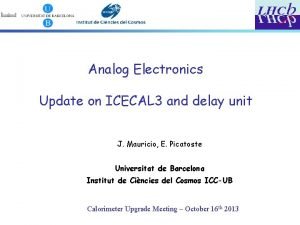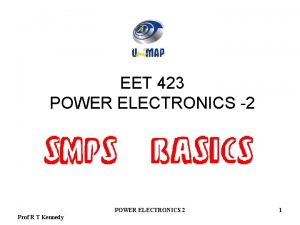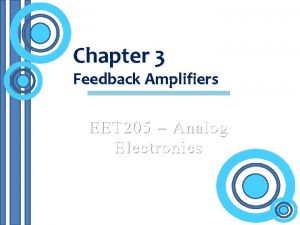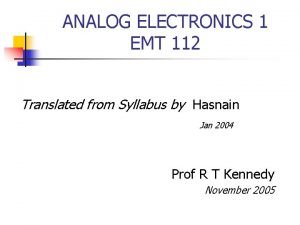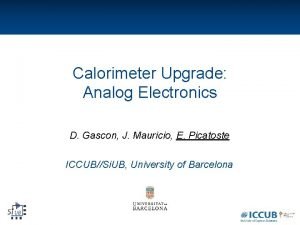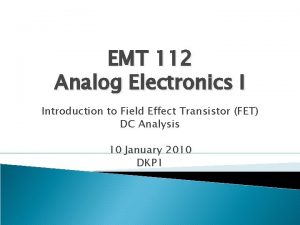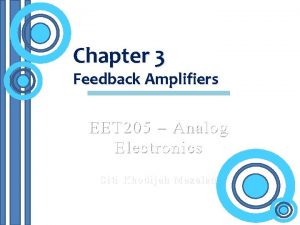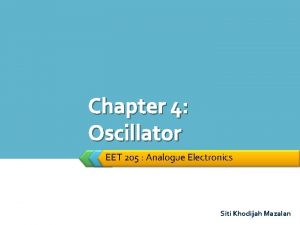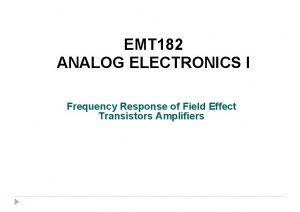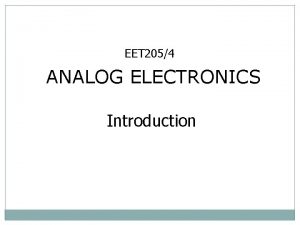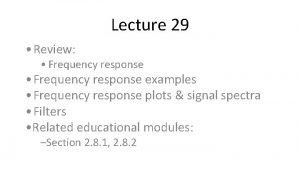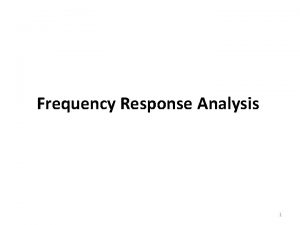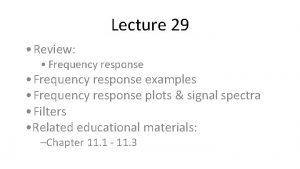ANALOG ELECTRONICS II FREQUENCY RESPONSE 1 Frequency Response












- Slides: 12

ANALOG ELECTRONICS II FREQUENCY RESPONSE 1

Frequency Response l l l Frequency response refers to how voltage gain varies as frequency changes AC amplifier – gain decreases when input frequency too low or too high DC amplifier – gain falls off at higher frequency Usually use d. B to describe the decrease in voltage gain Bode plot – to graph the response of an amplifier 2

Frequency Response of DC amplifier Aol (d. B) 3

Open-Loop vs Closed-Loop 4

High-frequency op-amp equivalent circuit V 1 + Vid Ro Ri Vout + V 2 - AVid - C Figure 1: High-frequency model of an op-amp with single break frequency 5

Frequency Response l What causes the gain of an op-amp to roll off after a certain frequency is reached? Note: roll off is the rate of decreases in voltage gain with frequency. For each ten times reduction in frequency below fc, there is a 20 d. B reduction in voltage gain. l Ans: Capacitive component Recall from basic theory: Read Floyd page 476, effect of coupling capacitor Reactance varies inversely with frequency l Reactance decreases frequency increases l 6

Frequency Response Two major sources are responsible for capacitive effects: ¡ Physical characteristics of semiconductor devices ¡ The internal construction l These two capacitances effect causes the gain of opamp to decrease as the frequency increases l Internal transistor capacitances Recall from basic concept: Read Floyd page 476 -477 7

Open-loop Frequency response l Refer to figure 1 Since and Thus, Hence the openloop voltage gain is 8

Open-loop Frequency response Let then Where Aol(f) = open-loop gain as a function of frequency A = gain of the op-amp at 0 Hz (dc) f = operating frequency (Hz) fo = break frequency of the op-amp (Hz) Open-loop gain magnitude Phase angle 9

Closed-loop frequency response q. Frequency bandwidth is measured at the point where gain falls to 0. 707 of maximum signal – The -3 d. B bandwidth q. Open loop configurations are extremely bandwidth limited q. Closed loop configuration significantly increases an opamp’s bandwidth 10

Circuit stability A system is said to be stable if its output reaches a fixed value in a finite time. l To test the stability of the systems : ¡ Analytical method – Routh-Hurwitz criteria ¡ Graphical method – Bode plots l How to determine stability? Method 1 ¡ Determine the phase angle when the (Aol)(B) is 0 d. B or 1. If the phase angle is > -180º ----- stable l Method 2 ¡ Determine the (Aol)(B) when the phase angle is - 180º. If magnitude is –ve d. B --- stable l 11

Closed-loop system Vin + Aol(f) Vo Vf B A typical closed-loop system (noninverting amplifier) where B = gain of a feedback circuit 12
